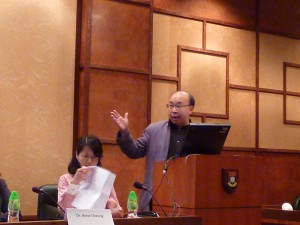 Saturday IP Dragon was at the conference ‘Charting the New Frontiers of Intellectual Property Protection of Luxury Brands’ organised by the University of Hong Kong. Professor Peter K. Yu of Drake University Law School, Des Moines in Iowa, U.S., gave an insightful presentation on some of the complexities of counterfeiting in China.
Saturday IP Dragon was at the conference ‘Charting the New Frontiers of Intellectual Property Protection of Luxury Brands’ organised by the University of Hong Kong. Professor Peter K. Yu of Drake University Law School, Des Moines in Iowa, U.S., gave an insightful presentation on some of the complexities of counterfeiting in China.
Already in 2005 Ernst & Young suggested that the luxury industry in China would first grow 20% per year and between 2008 and 2015 with 10% until sales would exceed 11.5 billion U.S. dollars in 2015 and “Chinese consumers could be as influential as the Japanese and account for 29% of all global luxury goods purchases. A temporary obstacle seems to be counterfeiting.
Professor Yu made it clear that in regard to counterfeiting in China location matters a great deal. It was often portrayed in the mainstream media that during the 2008 Olympics in Beijing, the central government was able to sufficiently enforce trademark related to the Olympics. However, outside the capital there were many counterfeit Olympic mascots visible and one sale in the streets. The saying “the mountains are high, the emperor is far away (山高皇帝远)” is still valid.
Professor Yu asserted that the estimations of the costs of piracy by the International Chamber of Commerce (ICC) 600 billion dollars and the Organization for Economic Cooperation and Development (OECD) 200 billion dollars, see more here, were used to win over politicians to turn it into laws such as SOPA, PIPA, ACTA and TPP.
A reference was made to “To Steal a Book is an Elegant Offense, Intellectual Property Law in Chinese Civilization” by professor William Alford. Professor Yu correct the view that this classic book only focuses on characteristics of Confucianism that might be incompatible or not conducive to protection and enforcement of intellectual property rights. The book also deals with China’s political culture which might give a more compelling explanation for China’s intellectual property challenges.
Professor Yu gave a useful taxonomy of counterfeits:
– A grade
– Low grade
– Unsafe
– Over runs/out of license goods
– Replicas
– Parallel imports, which are called Sui Fo 水貨 in Cantonese, which means water goods, as professor Yu explains, who is born in Hong Kong.
Then there is Shanzhai culture. Many Chinese take pride in these shanzhai products because they do not want to be dependent on foreign manufacturers that would dominate the Chinese market in some product categories.
Professor Yu shows also that counterfeiting and piracy can be looked at from different perspectives. One can look at it from the perspective of a judge, an economist (who can afford the genuine products), caretaker (who is going to be punished) and social planner (what will be the results if a plant is closed down).
As pointed out before law and especially intellectual property law is politics. Trademarks in China are according to Professor Yu not difficult to protect. He showed that the symbols of a brand, the trademark logo and name, represent the “face” of the company. And the concept of “face” is important in China. From a government point of view: trademarks in China are not politicized: it has not to do with money that needs to be invested in innovation, as is the case with patents in China, nor has it anything to do censorship, which is a big issue with copyrights in China. The cross-over point will be reached when China will have big brands of their own.
